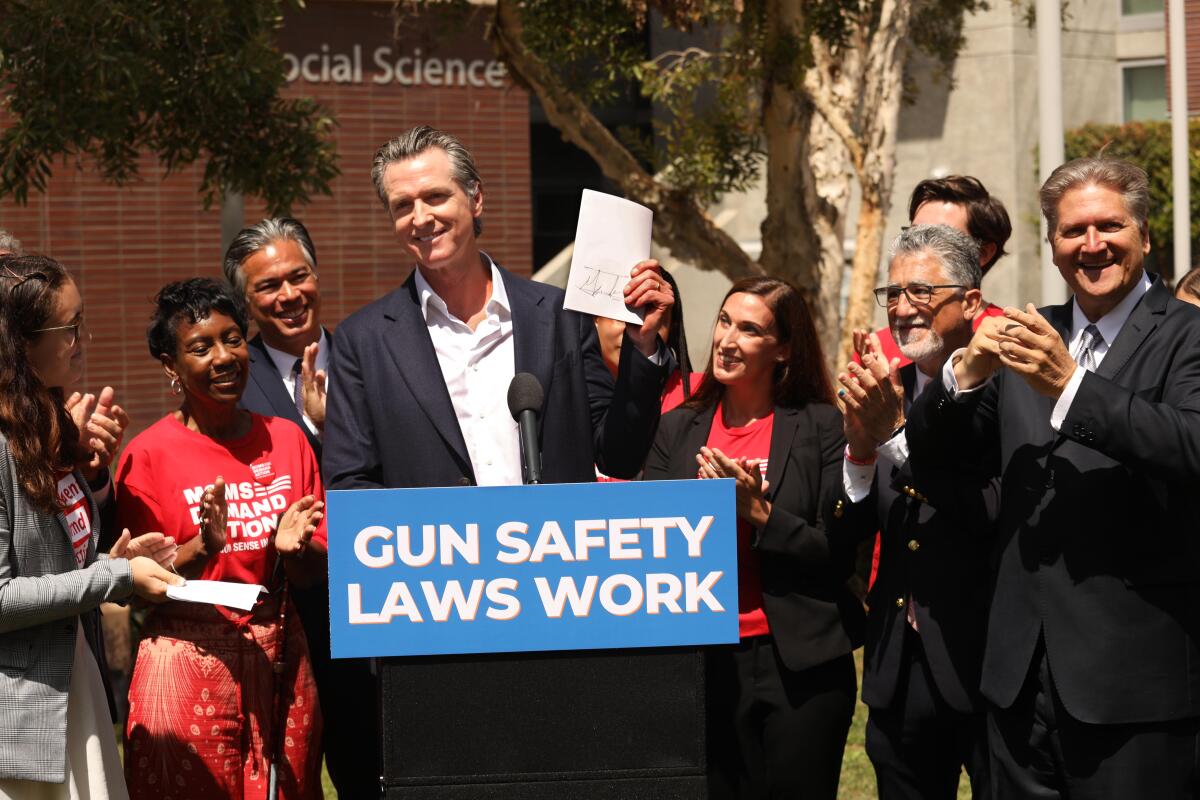Op-Ed: Is California’s new gun law, modeled after the Texas abortion law, constitutional?

The debate over California’s controversial new gun law, signed Friday by Gov. Gavin Newsom, seems to confuse two important questions: How can the law be challenged in court and, once challenged, is it constitutional?
The law, Senate Bill 1327, authored by Sen. Bob Hertzberg (D-Van Nuys), authorizes private citizens to file civil suits against gun makers and sellers in three circumstances. First, it focuses on “ghost guns,” firearms lacking serial numbers required by law, and allows a suit for $10,000 per weapon for anyone who manufactures, distributes, imports, transports or sells such weapons. Second, it is concerned with parts that can be used to build firearms, called “firearm precursor parts,” that are not allowed by the federal government and it creates civil liability for those who sell or purchase them. Third, it allows a suit for $10,000 each time a licensed firearms dealer sells or provides a firearm to any person under 21 years of age.
SB 1327 was explicitly modeled after a Texas statute, known as SB 8, which bans abortions at around six weeks of pregnancy and allows private citizens to sue anyone who aids and abets an abortion for $10,000 in damages. The goal of the Texas law is to limit the ability to challenge its constitutionality because it is not enforced by government officials, such as the state attorney general or district attorneys. In December, the Supreme Court in Whole Woman’s Health vs. Jackson, by 5-4, held that state officials can be sued in federal court over the constitutionality of a law only if they play a role in enforcing the law.
But that does not mean that such a law cannot be challenged in court. Someone who is sued under the law can argue as a defense that it is unconstitutional. Also, there can be suits in state courts to have the law declared unconstitutional and enjoined. The limits on litigation against state officials that apply in federal court do not apply in state courts. Indeed, the Supreme Court explicitly recognized these avenues for challenge in its December decision.
Eventually, then, the constitutionality of the new California law will come before the courts. The issue will be whether it violates the 2nd Amendment. Prior to the Supreme Court’s decision on June 23, in New York State Rifle & Pistol Assn. vs. Bruen, which struck down a New York law restricting concealed carrying of firearms in public, I would have said without hesitation that the new California gun law was constitutional. Now, that is a harder question given the court’s ruling.
In that decision, the majority opinion by Justice Clarence Thomas said that gun regulations are allowed only if they were historically permitted. He wrote: “Only if a firearm regulation is consistent with this Nation’s historical tradition may a court conclude that the individual’s conduct falls outside the Second Amendment’s ‘unqualified command.’”
Courts will need to consider whether each of the three parts of the new California law meets this test and is a type of regulation that has been historically permitted. The difficulty, of course, is that neither the weapons involved nor the regulations created by the law existed in 1791, when the 2nd Amendment was adopted, or in 1868, when the 14th Amendment was ratified.
Although the first federal gun law was not adopted until 1934, the colonies began regulating firearms before the United States was formed. Virginia adopted a law in 1619 and colonial and early state governments adopted over 600 gun control restrictions. Laws requiring registration, which is facilitated by serial numbers, have long existed and thus the part of SB 1327 dealing with ghost guns should easily be upheld by the courts.
Likewise, the courts long have upheld restrictions on particular types of weapons. In 1939, the Supreme Court upheld a federal ban on sawed-off shotguns. Prohibiting the possession of parts of guns that are prohibited by the federal government likewise should be constitutional.
Ironically, under Thomas’ decision, the provision prohibiting the sale or distribution of firearms to those under age 21 could be in trouble. This regulation should clearly be constitutional. In fact, under current federal law, licensed dealers cannot sell or deliver handguns to individuals under age 21 or long guns such as shotguns and rifles to those under age 18. But it is uncertain whether the courts will find a historical basis for this age restriction. I hope that courts will follow common sense and conclude that it is best for society to do all it can to keep guns out of the hands of minors.
The new California law, like the Texas law, limits how a defendant can challenge its provisions in court, but it is not immune from review in the courts. Once challenged, courts should uphold the regulations as reasonable and consistent with the 2nd Amendment.
Erwin Chemerinsky is dean of the UC Berkeley School of Law and a contributing writer to Opinion. He is the author, most recently, of “Presumed Guilty: How the Supreme Court Empowered the Police and Subverted Civil Rights.”
More to Read
A cure for the common opinion
Get thought-provoking perspectives with our weekly newsletter.
You may occasionally receive promotional content from the Los Angeles Times.










